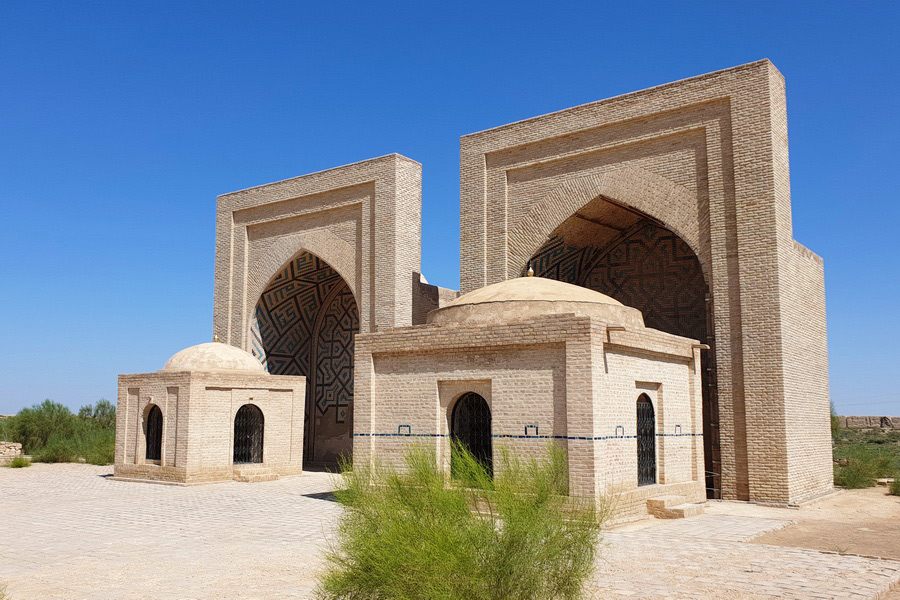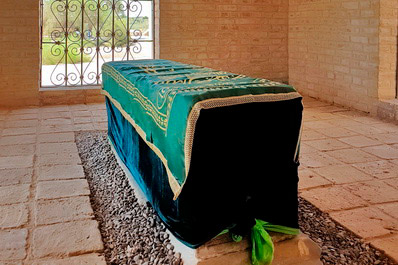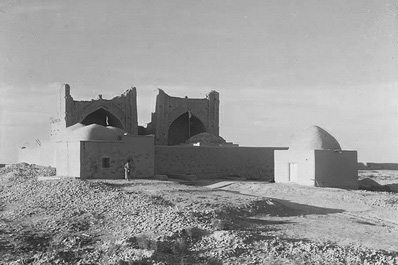Askhab Mausoleums, Merv

The Mausoleums of the Askhabs is an important religious complex in the centre of Merv where two companions of the Prophet Muhammad - Buraydah ibn al-Husayb al-Aslami and Al-Hakam ibn Amr al-Ghifari - are buried. Sometimes referred to as the "Shrine of the Brothers of the Askhabs", the term "Askhabs" or "Sahabah" comes from Arabic and means "companion". It refers to those who personally saw the Prophet, believed in him and accepted Islam.
These two mausoleums are located 300 metres south of the walls of Sultan Kala Fortress. Buraydah ibn al-Husayb al-Aslami died in Merv at the end of the 7th century and were buried at this site, which soon became a local shrine. In the 10th and 11th centuries, small domed structures were built over the tombs, but the larger mausoleums, reaching a height of 12 metres, were not built until the 15th century, when Merv became part of the Timurid Empire. At this time, a sardoba - an underground water reservoir with a domed top - was also built near the mausoleums. Although Merv was eventually abandoned and the mausoleums fell into disrepair, pilgrims continued to visit. By the late 19th century, when Russian travellers explored the ruins of Merv, the mausoleums had deteriorated considerably. A restoration in 1914 restored their former appearance, and a second restoration by Turkish craftsmen took place in 2013.
When the mausoleums were built in the 15th century, black marble headstones were placed over the tombs, intricately carved with the names of the Askhabs and decorated with plant motifs. At the rear of the mausoleums, aivans or open porticoes were added, originally decorated with blue and turquoise tiles, although few of these have survived. On the back wall of the hall is the word "Allah" in large Kufic script.
In the right tomb lies Buraydah ibn al-Husayb, a member of the Aslam tribe. He met the Prophet Muhammad during the Hijrah, when Muhammad was travelling from Mecca to Medina. Buraydah initially tried to capture the Prophet, but after talking to him, he changed his mind, accepted Islam and became one of Muhammad's protectors. Legend has it that when the Prophet arrived near Medina, Buraydah suggested that he enter the city with a banner. Using a bandage from his own head, Buraydah made a makeshift banner and became Muhammad's standard bearer. Buraydah went on to take part in many military campaigns to spread Islam, including the conquest of Khorasan, of which Merv was the capital. A hundred years after his death, during the Seljuk Empire, the southern gate of Sultan Kala was named Alamberdar, meaning "The Standard Bearer", in his honour.
In the left tomb lies al-Hakam ibn Amr, a member of the Ghifari tribe. He also served as a standard bearer for the Prophet Muhammad, while his brother Rafi was known for transmitting hadiths, or sayings of the Prophet. Like Buraydah, al-Hakam took part in the military campaign against Khorasan, and after the capture of Merv he was appointed governor and commander of the Arab army's headquarters. He lived in Merv for five years and died there.
Today, the Mausoleums of the Askhabs are one of the most important religious monuments in Merv and Turkmenistan. Thousands of pilgrims visit the site every year. When exploring Merv, a visit to the graves of the Prophet's companions - people who lived at the very beginning of Islam - is a meaningful and significant experience.


